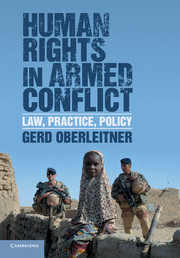Book contents
- Frontmatter
- Contents
- Acknowledgments
- Table of cases
- Table of Legal Instruments
- List of Abbreviations
- Introduction
- Part I Human rights in armed conflict: history of an idea
- Part II Human rights and humanitarian law: theory
- Part III Human rights and humanitarian law: challenges and commonalities
- Part IV The dynamics of war and law
- 13 The changing character of war
- 14 Governing internal armed violence
- 15 Human rights in situations of occupation
- 16 Context: the humanization of international law
- Part V Enforcement: practice and potential
- Conclusion
- Bibliography
- Index
- References
15 - Human rights in situations of occupation
Published online by Cambridge University Press: 05 March 2015
- Frontmatter
- Contents
- Acknowledgments
- Table of cases
- Table of Legal Instruments
- List of Abbreviations
- Introduction
- Part I Human rights in armed conflict: history of an idea
- Part II Human rights and humanitarian law: theory
- Part III Human rights and humanitarian law: challenges and commonalities
- Part IV The dynamics of war and law
- 13 The changing character of war
- 14 Governing internal armed violence
- 15 Human rights in situations of occupation
- 16 Context: the humanization of international law
- Part V Enforcement: practice and potential
- Conclusion
- Bibliography
- Index
- References
Summary
Law of occupation: governing fragility in hostility
The law of occupation was inserted as Section III (Articles 42 to 56) in the 1899 Regulations respecting the Laws and Customs of War on Land annexed to Hague Convention II of 1899, and revised and attached under the same title to the Hague Regulations respecting the Laws and Customs of War on Land annexed to Hague Convention IV of 1907. The delegates to the negotiations of the texts presumed that once the enemy was overpowered by force, this would lead to the enemy government being rendered dysfunctional and displaced by the victorious government’s exercise of temporary authority with a view towards restoring peace again in a peace agreement. As in other fields of international humanitarian law the drafters of these first rules on occupation could neither anticipate the rise of international human rights law nor could they imagine how occupations would become part of multi-faceted post-conflict scenarios.
Geneva Convention IV of 1949 followed the model provided in 1907. Section III of the Convention created, under the title “occupied territories,” a set of protective rules for civilians under occupation to supplement the Hague Regulations and envisaged also occupations which were not necessarily preceded by war. Based on its nineteenth century foundations, the law of occupation soon began to evolve into a matrix of considerations which included, and needed to reconcile, the security needs of the occupier; the humanitarian concern for the fate of civilians; the idea of self-determination of peoples; the demands of nation (re)building; and the human rights of the occupied population. Additional Protocol I of 1977 also contains a number of rules on occupied territories, most of them complementary to Geneva Convention IV, others more innovative and partly in response to such challenges.
- Type
- Chapter
- Information
- Human Rights in Armed ConflictLaw, Practice, Policy, pp. 220 - 231Publisher: Cambridge University PressPrint publication year: 2015
References
- 1
- Cited by



